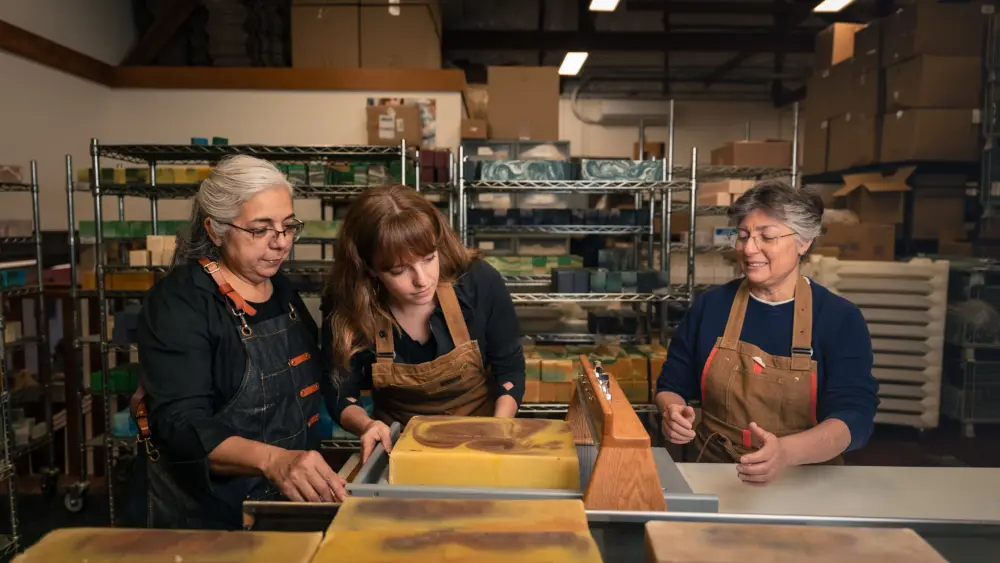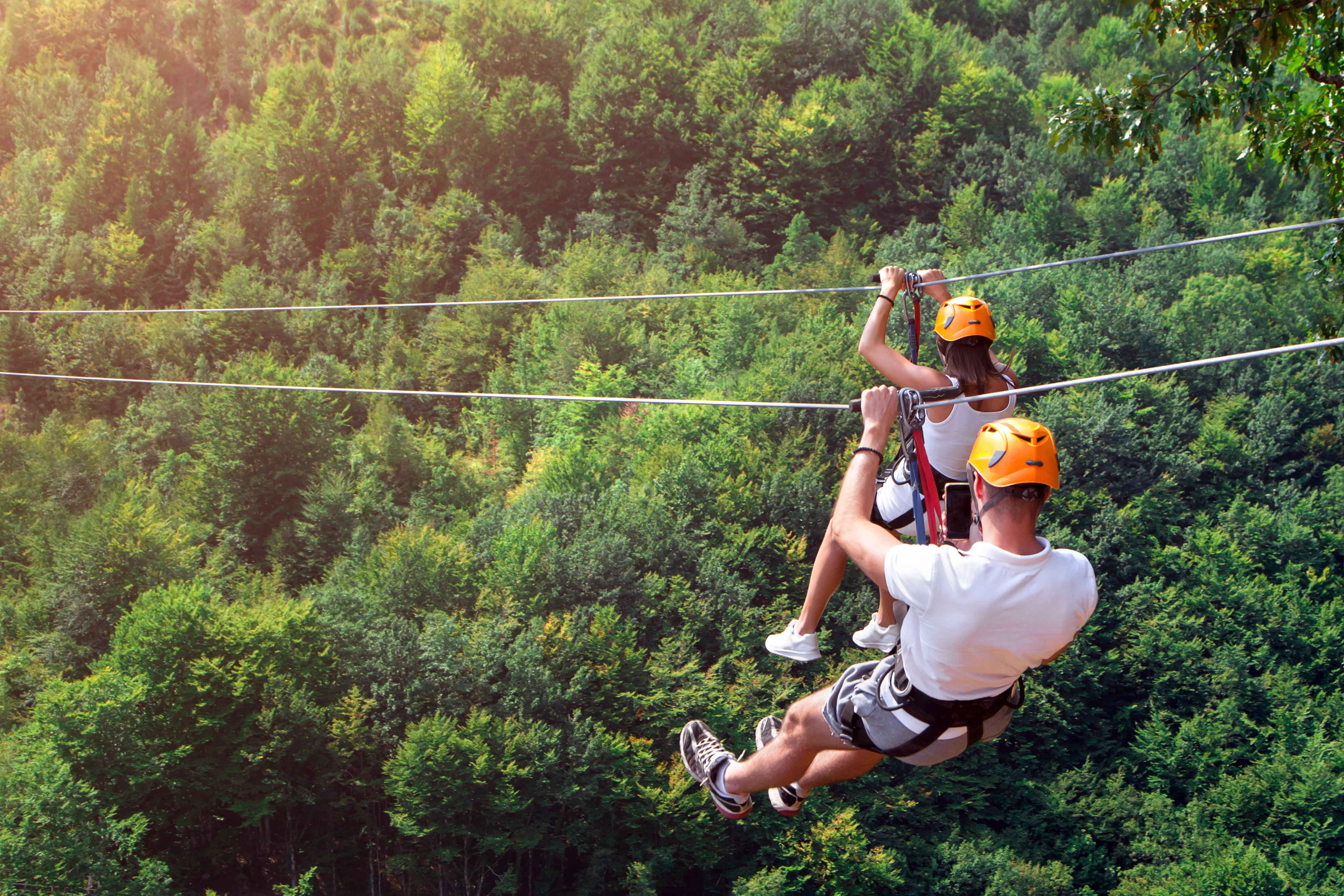
Modern ziplining got its start in the 1970s when a Cal State doctoral student fashioned zipline prototypes in Costa Rica to help with his studies of local wildlife.
Gliding through the air suspended from a cable with the ground far below is an unforgettable experience. And it’s right at home in the North Bay’s redwood forests, where ziplines gives riders a rare view of the natural world while delivering intangible benefits. It might satisfy a craving for adventure, provide a chance for a personal challenge or give one a greater appreciation of nature. Whatever the reason, thousands of people are donning harnesses and helmets and venturing onto ziplines to get a bird’s eye view of an area’s landscape and make memories that will last a lifetime.
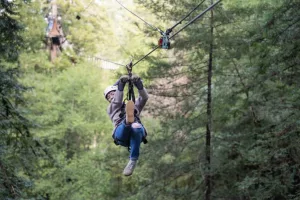
Modern ziplines trace their origin to the 1970s, when Donald Perry, a graduate student at California State University, Northridge, who was studying the wildlife of Costa Rica for a doctorate in biology, designed and built a zipline to help with his research. He needed a way to observe the forest canopy without disturbing the environment or dealing with biting insects, and a zipline allowed him to travel aloft through the rainforest and get a clear view of the canopy and its denizens without climbing trees. His innovative use of an old method attracted the attention of the media, and in 1995, Darren Hreniuk, a Canadian, followed Perry’s example and built the first recreational zip course in Costa Rica. From there, ziplining for sport spread, and since then, it has become increasingly popular. Today, the United States boasts more than 400 ziplines, with two operators in Sonoma County giving people of a wide range of ages the opportunity to soar either through or over stands of giant redwood trees, sharing fresh air and open spaces with birds and other flying creatures.
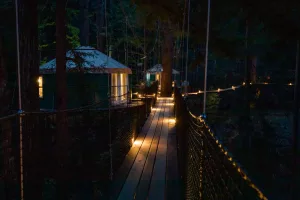
Terri Carrillo of Santa Rosa has visited Sonoma Zipline Adventures in Occidental three times. The first time, she wanted to try ziplining because it was something new, and she and her partner went with his daughter and her fiancé, who were in their 20s. They did Forest Flight, a canopy tour 200 feet high that goes through the redwood trees and was the only course at the time. On her second outing, she did Tree Tops, which is newer, 50 ft. higher and goes above the trees. It is reputedly the longest line in Northern California. This time, the tour was a treat for her 18-year-old goddaughter so they could do something special together before she left for college. “We had a blast. It was so much fun,” says Carrillo. She did Tree Tops again in October 2022 with eight friends she’d worked with during her career in the corporate world, who had come from Wisconsin to visit and enjoy a week’s worth of activities. They were all in their 60s and 70s, and “Some people in their 20s joined us, and they were impressed that we were doing this,” she reports. Next, she says, “I’d like to do the overnight. Now they have beautiful treehouses.”
Sonoma Zipline Adventures is located at Alliance Redwoods Conference Grounds, a 75-year-old faith-based 501(c)3 nonprofit organization that operates a camp and conference center to serve the community and churches. Revenues from the zipline business allow the Conference Grounds to serve people such as refugees and foster children, and among their efforts to help others, they housed unsheltered individuals during the COVID-19 pandemic. It is however, essentially a 125-acre outdoor classroom that gives visitors a chance to develop a connection between themselves and nature, so ziplines are a good fit.
“The very first course was built in 2010, and in 2017, we added the Tree Tops course,” says Dan Ferguson, chief of staff for the site, who has been in the position for going on two years. “During COVID in 2020, we built the treehouses,” he adds, thereby offering a new experience that allows guests to stay overnight and embark on a 24-hour zipline adventure that includes both courses. In addition, night zips are a feature of the warm months from May through August, and riders wear helmets with lights as they venture out to see the moon and stars. Sonoma Zipline Adventures does at least 40 tours a day, rain or shine, and in summer, during the peak season, that number grows to as many as 60 tours daily. Visitors numbered 22,000 in 2023, in a testament to the increasing popularity of ziplines.
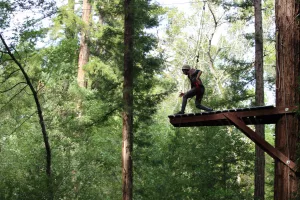
Challenge Sonoma Adventures Ropes Course, which has been in operation since 1984, offers ziplining as one of several high elements at its site four miles from the City of Sonoma on Sonoma Mountain. Founder Diana Rhoten explains that most people go to a zipline course to have an adventure, but “We differ from zipline canopy tours in that we are experiential educators in an outdoor setting,” she says, explaining that a day at Challenge Sonoma starts with low elements such as swings and ladders that sequence up to activities higher in the redwoods. “For so many of our groups, it’s about being afraid of heights and working through it,” she says. While ziplines riders usually use harnesses they sit in and can grasp the harness that straps them to the line, participants at Challenge Sonoma are on their backs in full-body harnesses, so they don’t have anything to hold onto. “You’re giving it up to trust,” she says. Most of their clients are groups engaged in leadership and team-building activities, corporate events or wilderness adventures, and individuals and families are welcome one day each weekend.
Challenge Sonoma’s Nature Adventure Camp at Carriger Creek gives children 9 and up a chance to try their own zipline in one of several activities in one-week summer sessions. It’s 30 ft. high and 300 ft. long and is strung between sturdy poles, because the area doesn’t have redwood trees. “It’s something they lead up to. It’s not necessarily on the first day,” says Rhoten, explaining that some kids are ready to fly, while others climb up to the line and want to get right back down. They can try it more than once, so if they don’t do it right away, they have other chances. “We stress individual personal goals,” she says, and they encourage everyone—children and adults—to go as far as they can, physically, mentally and emotionally. That makes the role of guides or counselors especially important, because they need to be experienced facilitators who can work with participants to make them feel safe. They have 40 hours of training and must have a year or two of experience before working on a platform. “It all depends on their skills,” she says, because they need to be able to work with all kinds of people who react to the activities in different ways. They also learn to do emotional and physical rescues, which they often anticipate, “The whole thing is about having butterflies. It’s not about waiting until you’re not afraid to try it,” she says, explaining that it’s better to take the leap while you’re frightened, and have faith, because you’ll go farther than you ever thought you could.
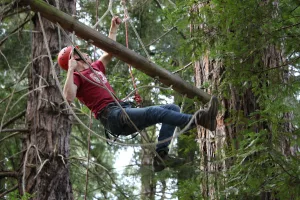
Leading the way
Guides at Sonoma Zipline Adventures also have a minimum of 40 hours training, and they tend to be young adults who are in college or have just graduated. “It’s very transient; there’s a lot of turnover,” says Ferguson. “We have a whole crew that comes back every summer.”
Reece Phillips, who has been a course manager at Sonoma Zip Line Adventures for four and a half years and has 15 years’ experience in the zipline business, oversees training and inspections. He explains that guides must have one week of training to be a sweep guide, who helps riders get launched on the starting platform, and another week to be a lead guide, who works on the platform where riders land. In addition, a trainee follows a guide, and a guide follows a trainer, so those in training can observe and learn good practices as well as having their own performance evaluated. Guides have medical training and learn to perform CPR, and they are trained in rescues, because sometimes a person does one or two lines and doesn’t want to continue, so guides must lower them to the ground at strategic spots.
Guides also need to learn soft skills, such as conflict resolution and how to talk to people in difficult situations. Phillips explains that the two most common issues are fear of heights and people who have been pressured into doing something that’s not their choice. He’s even seen people arrive at the site with a group, completely unaware that they’re going to be ziplining and less than enthusiastic.
He reports that the company started a training program and created an 80-page training manual that’s a manual on the 40-hourse course from start to finish, which regularly undergoes revision. In addition, some staff members attend an annual conference and learn about the latest trends as well.
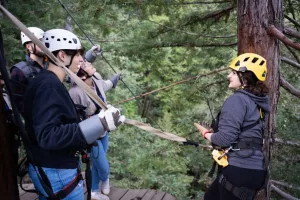
As a business, zipline operators must follow regulations at the federal, state and county level. They fall into the same category as amusement park rides and are similarly regulated, so they require inspections and need permits to operate. They also have additional requirements for harnesses, braking systems and lines installed in trees. The Association for Challenge Course Technology is a trade organization that has its own set of standards for inspecting and building that are recognized in the United States, and “We try to follow their standards,” says Ferguson. He reports that Challenge Works, an ACCT Professional Member Vendor that specializes in equipment for aerial adventures, built the platforms and is involved in inspection and maintenance as well as training, certification and course design.
He explains that a Professional Vendor Member inspects ziplines, platforms and equipment once a year. An arborist inspects the trees annually, and the six treehouses also require inspections. Meanwhile, “In-house we do an inspection once a month,” he says, and the staff inspects lines and equipment daily to make sure everything is in good working order.
Challenge Sonoma also follows ACCT standards, and Rhoten explains that ziplining is a self-regulated industry, and ACCT sets its standards higher than OSHA or the state. An ACCT vendor built Challenge Sonoma’s course, and it undergoes inspection twice a year. In addition, “I’m a qualified person to train,” she says, and she has 37 years of experience and goes to conferences to keep her skills up to date and make sure the facilities are state of the art.
Getting started
To get ready for a zipline tour, make sure you meet the course’s requirements. The minimum age at Sonoma Zipline Adventures is 10, and age doesn’t have an upper limit. Carmen Taylor of Santa Rosa tried it for the first time last year at the age of 90. “It was on her bucket list,” says Ferguson. The weight range is 70 to 250 lbs., and zipliners are strapped into a harness, so clothing should be comfortable and take into consideration the weather, because it can feel hotter on hot days and cooler on cold days. Shoes should have closed toes—no flipflops, which could easily slip off—and Sonoma Zipline Adventures collects valuables for safekeeping so that people don’t risk having items fall from their pockets to the forest floor.
Challenge Sonoma allows mobile phones for taking photographs, but, otherwise, “The goal is zero technology,” says Rhoten. She recalls teachers taking phones away from a class of high-school seniors, and they didn’t like it at first. Soon, though, they began to see nature in an incredible redwood forest and completely forgot about their phones.
While Challenge Sonoma starts with low elements, and clients gradually make their way up to higher ones, zipliners at Sonoma Zipline Adventures board a truck to head up to the first level, where they get training. Carrillo went through a practice, where she learned how the harness and brakes work and did a rehearsal on a little zipline a few feet off the ground. The trainer explained how the guides would help at each end and instructed the zipliners on what they could and could not do. Next, they headed up hill to the appropriate level to start the course. She found that taking the first step off the platform was exciting, although still a little unnerving, but “The guides secure you and make sure you’re ready and don’t push you,” she says, adding that they’re reassuring and don’t cut corners. The only challenge she had was rappelling down the tree at the end of the course on her first trip. “Releasing and swinging out was scary for me,” she says, and it took some courage. The second time, though, “It was old hat.” Once she was out on the first leg of the course, she discovered how beautiful it was to be so high, listening to the silence and seeing nature. “You don’t realize how much the trees move,” she says. “It’s not scary. It’s just exciting.
Children at Nature Camp feel the excitement of discovery, as they climb, zipline, explore and experience nature, often in an entirely new way. “Lots of kids don’t know they can hike in the forest,” says Rhoten and the activities the camp offers open their eyes to nature and their own possibilities. “It’s about doing it and being out there and experiencing it,” she says, explaining that when they see a rock or leaf close up instead of in a book, they remember it. In addition, the only people they have to compete with are themselves. She would like the experience to be accessible to everyone and says, “A future goal is to have an adapted course so we can offer more challenges for disabled individuals.”
Ziplining can be recreational, educational and social, and it can stand alone or be combined with other activities. Either way, the feeling one experiences is incomparable. “You hear the screams of joy. It’s exhilarating. I’ve probably gone a dozen times, and it’s the same every time. It’s a ton of fun, says Ferguson. “Between our guides and the redwood forest, it really is a unique, fun experience.”
“Go, and go with friends,” Carrillo advises. The zipline course takes a couple of hours, and she recommends going in the morning and then having lunch at the old hotel in Occidental, where you can relive the experience. “I was with some great people each time,” she says. “It’s something that’s really great to share.”



